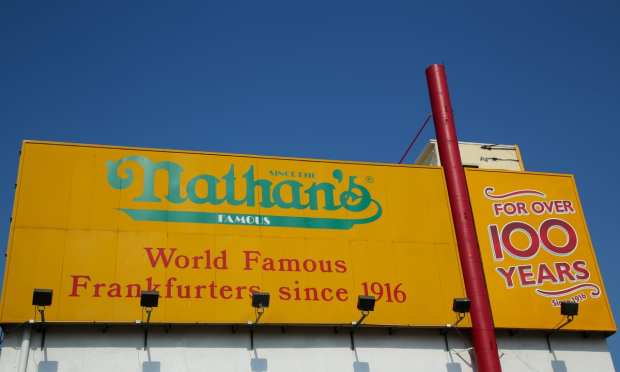Nathan’s Famous Doubles Down On Ghost Kitchens As Hottest QSR Trend Accelerates

It wasn’t long ago that the ghost kitchen concept – and even the term – didn’t exist. But today, after 14 months of pandemic-related lifestyle changes, ghost kitchens have gone from the fringe of acceptance to a mainstay of the restaurant industry.
Nowhere has the embrace of takeout-only restaurants been more pronounced than at the iconic hotdog firm Nathan’s Famous, which has been at the vanguard of this growing movement. Not only has Nathan’s rolled out 100 ghost kitchens in under eight months and has also just announced plans to open 100 more, but its new Wings of New York virtual brand just launched its first physical storefront in the most conspicuous of places: Yankee Stadium.
While the expansion was certainly accelerated by the pandemic-driven turn toward online ordering, the company has actually been planning its ghost kitchen launch “as much as six months prior to COVID,” James Walker, the company’s senior vice President of restaurants, told PYMNTS in a recent interview.
“We knew that the direction the restaurant industry was moving was all about accessibility,” Walker recalled. “Drive-thrus and delivery and off-premises — you could just see the numbers escalating. And we said, we don’t want to jump on that train. We want to get there before the train.”
At the time, he noted, the term “ghost kitchen” was barely in circulation. The team discussed these nontraditional locations as “commissaries” or “delivery-only kitchens.”
The COVID-19 Ghost Kitchen Tailwind
With these delivery-only kitchens already in the pipeline, the quick-service restaurant (QSR) company took the opportunity provided by the pandemic to go all-in on the model. In the initial months of lockdown, he said, the company reflected that these ghost kitchens were “the right thing for the business,” predicting they were “Not only going to pay dividends in the short term, but it’s a good long-term solution and opportunity for us.”
While the pandemic’s effect on the restaurant industry was at times devastating, this did leave an opportunity for Nathan’s Famous to work with operators seeking ways to drive profits without incurring major additional costs.
“Because we were working with independent restaurateurs well as the big national providers,” Walker recalled, “[for] these independent restauranteurs, the additional revenue that putting in a Nathan’s Famous and Wings of New York satellite kitchen provided them might be the difference between staying in business or not.”
In fact, he said, the company is now closing deals for new ghost kitchens almost every week, growing the brands’ presence nationally and abroad.
Making The Model Work
Not all have had the success in the ghost kitchen space that Nathan’s Famous has had, despite the almost magic bullet-like rhetoric around the model claiming that ghost kitchens are effectively a no-brainer. While, without the real estate costs associated with maintaining a dining room and a front of house team, these locations can be more capital expenditure-efficient, they nonetheless require support.
Successful ghost kitchens, Walker said, ask, “How are you going to support it from an operational standpoint? How are you going to support it from a marketing standpoint? How are you going to monitor it from a quality assurance standpoint?”
As an example of marketing support, he explained that for a new Wings of New York location in a given market, the company’s Twitter advertising would be targeted “only to that delivery area, only during meal time, only to individuals of a purchasing age.” He added that the company would target certain keywords “like wings or foodie,” and that ad effectiveness would be tracked by click-throughs.
“We love how analytical and how efficient the spend is for this channel,” he said.
Conversely, he said, unsuccessful virtual brands are those that try to slap a new logo on their existing menu items without investing in the brand experience.
“I don’t think those providers have … been successful,” he said. “I think we’re already beginning to see some of them shake out.”
The Future Of The Ghost Kitchen
Looking ahead, Walker predicts that the brands that have been launched “opportunistically” will continue to fall by the wayside as consumer return to restaurants, while we may see more ghost kitchens emerge as a way for newcomers to try out riskier concepts.
“This ghost kitchen movement allows young entrepreneurs who have great ideas for new food and new flavors and new brands — it’s a way for them to get into the business in a way that they never would have been able to before,” Walker said.
Of course, for a delivery-only kitchen to work, the delivery system itself needs to work, and third-party delivery services remain a source of strain for many restaurants both in terms of their fees and in terms of their relationships with their customers.
He predicts we will see “continued pressure on the third-party delivery companies to be good partners with their host restaurants,” especially from a “sharing of information” standpoint, with pressure to “provide restaurants the mechanism to allow them to compete” both data-wise and financially.
In terms of the ghost kitchen future for Nathan’s Famous specifically, he said, “We’re very bullish on the next 12 months. We’re really excited that we seem to be off to a great start so far.”
